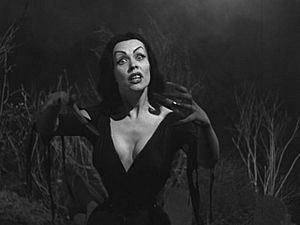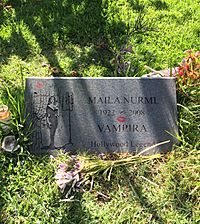Maila Nurmi facts for kids
Quick facts for kids
Maila Nurmi
|
|
|---|---|

Nurmi in 1947
|
|
| Born |
Maila Elizabeth Syrjäniemi
December 11, 1922 |
| Died | January 10, 2008 (aged 85) Los Angeles, California, U.S.
|
| Resting place | Hollywood Forever Cemetery |
| Other names | Maila Niemi Nurmi Maila Elizabeth Nurmimioni Vampira |
| Occupation | Actress |
| Spouse(s) |
John Brinkley
(m. 1958) |
Maila Elizabeth Syrjäniemi (born December 11, 1922 – died January 10, 2008) was an American actress. She became famous for creating the unique 1950s character known as Vampira.
Maila grew up in Astoria, Oregon. She worked in canneries before moving to Los Angeles in 1940. She hoped to become an actress. After some small movie roles, she became very successful with her Vampira character. Vampira was television's first horror host. Maila Nurmi hosted her own show, The Vampira Show, from 1954 to 1955. It aired on KABC-TV.
After her show ended, she appeared in the 1959 movie Plan 9 from Outer Space. This film was directed by Ed Wood. She also played a beatnik poet in the 1959 film The Beat Generation. In this movie, she did not play her Vampira character. Maila Nurmi was later played by Lisa Marie in the 1994 movie Ed Wood, which was about the director.
Contents
Early life and background
Maila Nurmi was born to Onni Niemi and Sophia Peterson. Her father was a Finnish immigrant, and her mother was American with Finnish family. Maila was born in Gloucester, Massachusetts. During her career, she sometimes said she was born in Finland. However, her personal diary showed this was not true.
As a child, Maila's family moved from Massachusetts to Ashtabula, Ohio. They then settled in Astoria, Oregon. Astoria had a large Finnish community. Her father worked as a lecturer and editor. Her mother was a part-time journalist and translator. Maila finished high school in Astoria in 1940.
Maila Nurmi's career journey
Starting out in entertainment
In 1940, Maila Nurmi moved to Los Angeles, California. She wanted to become an actress. She also spent time in New York City. She worked as a model for famous artists like Alberto Vargas and Man Ray. This helped her get into the film world. She had a small, uncredited role in the 1947 film If Winter Comes.
She also worked on Broadway in a horror-themed show called Spook Scandals. Maila was a showgirl and a dancer. In the 1950s, she posed for photos in men's magazines. Before becoming Vampira, she worked as a hat-check girl in Hollywood.
How Vampira was created
The idea for the Vampira character came about in 1953. Maila Nurmi went to a costume party. She dressed up like a character from The New Yorker cartoons. This character was later named Morticia Addams. Her pale skin and black dress caught the eye of TV producer Hunt Stromberg, Jr.. He wanted her to host horror movies on KABC-TV in Los Angeles.
Maila's husband, Dean Riesner, came up with the name Vampira. Maila's character was also inspired by the Dragon Lady from the comic strip Terry and the Pirates. She also got ideas from the evil queen in Disney's Snow White and the Seven Dwarfs.
The Vampira Show first aired on May 1, 1954. Each show began with Vampira walking through fog. She would let out a scream. Then, she would introduce the movie. She often made jokes about horror. She even talked to her pet spider, Rollo.
The show became very popular right away. In June 1954, she appeared as Vampira on The Red Skelton Show. Life magazine also wrote an article about her. They showed photos of her famous scream.
When her KABC show was canceled in 1955, Maila kept the rights to her Vampira character. She moved the show to another TV station, KHJ-TV. Some old clips of her show still exist today. They are used in documentaries like American Scary and Vampira: The Movie.
In 2014, it was confirmed that Maila Nurmi was the model for Maleficent. Maleficent is the evil witch in Disney's 1959 film Sleeping Beauty.
Maila Nurmi made television history. She was the first horror movie hostess. Other TV stations later copied her idea. They had their own spooky hosts for horror films. In 1954, she was nominated for an Emmy Award.
Her most famous movie role was in Ed Wood's Plan 9 from Outer Space. She played a zombie who looked like Vampira. This movie was filmed in 1956 and released in 1959. A clip of her walking from the woods was used in the opening of Chiller Theatre in New York.
Later years and legacy
By 1962, Maila Nurmi was installing linoleum floors. She also did carpentry and refinished furniture.
In the early 1960s, she opened an antique shop called Vampira's Attic. It was on Melrose Avenue. She sold handmade jewelry and clothes. She made items for celebrities like Grace Slick.
In 1981, KHJ-TV asked Nurmi to bring back her Vampira character. She worked on the new show. However, she left the project because of disagreements. The station hired actress Cassandra Peterson to play a similar character. The show was then renamed Elvira's Movie Macabre. Maila Nurmi later filed a lawsuit about the character rights. The court decided in favor of Peterson.
In 1986, Maila appeared in the punk rock musical Population: 1. She also recorded two songs with the band Satan's Cheerleaders in 1987.
In 2001, Nurmi started her own website. She sold signed items and her artwork online. She lived in a small apartment in North Hollywood until she passed away.
Unlike Elvira, Maila Nurmi did not allow many products to be made using her Vampira character. However, some companies used her name and look without permission. She did approve a Vampira model kit in 1994. She also approved a figurine in 2001. In 2004, she allowed Coffin Case to use her character for skateboards and guitar cases.
Personal connections
In the early 1950s, Maila Nurmi was friends with actor James Dean. They spent time together in Hollywood. People often talked about their friendship. A photo exists of Dean and Vampira's sidekick Jack Simmons in Frankenstein makeup. This shows their friendly connection. James Dean also watched The Vampira Show on TV.
The English punk rock band the Damned wrote a song about their relationship. It is called "Plan 9, Channel 7."
Marriages
Maila Nurmi was married three times.
- In 1949, she married her first husband, Dean Riesner. He was a former child actor. He later became a screenwriter for movies like Dirty Harry.
- Her second husband was actor John Brinkley. They married on March 10, 1958.
- She married actor Fabrizio Mioni on June 20, 1961.
Death
Maila Nurmi died on January 10, 2008. She was 85 years old. She passed away from natural causes in her Hollywood apartment.
Filmography
| Year | Title | Role | Notes |
|---|---|---|---|
| 1947 | If Winter Comes | Guest | Uncredited |
| 1948 | Romance on the High Seas | Passenger | Uncredited |
| 1952 | My Hero | Letitia | Episode: "Lady Mortician" |
| 1954 | The Red Skelton Hour | Vampira | Episode: "Dial 'B' for Brush" |
| 1954 | The Vampira Show | Vampira | Numerous |
| 1956 | Vampira Returns | Vampira | |
| 1957 | Playhouse 90 | Vampira | Episode: "The Jet Propelled Couch" |
| 1959 | Too Much, Too Soon | N/A | Uncredited |
| 1959 | The Beat Generation | beatnik poetess | As Vampira |
| 1959 | Plan 9 from Outer Space | Vampire Girl | As Vampira |
| 1959 | The Big Operator | Gina | As Vampira |
| 1960 | I Passed for White | Girl Poet | Uncredited |
| 1960 | ... Kittens Go to College | Edna Toodie | Uncredited |
| 1962 | The Magic Sword | The Hag / Sorceress | |
| 1986 | Population: 1 | Mother | Uncredited |
| 1992 | Flying Saucers Over Hollywood | As Herself | Plan 9 Documentary |
| 1995 | Horror Kung-Fu Theatre | Vampira | Episode: "Honorary Cast Members of HKFT" |
| 1996 | Dry | Vanha nainen | Short film |
| 1998 | I Woke Up Early the Day I Died | Woman in Hotel Lobby | |
| 2000 | No Way In | Woman at Bar | Short film |
Awards and recognition
- Maila Nurmi and The Vampira Show received a special award. This was for being the first TV horror host show. It happened at the 50th Anniversary of the Emmy Awards.
- Nurmi was added to the Monster Kid Hall of Fame after she passed away. Vampira: The Movie also won an award as a tribute to her.
See also
 In Spanish: Maila Nurmi para niños
In Spanish: Maila Nurmi para niños




